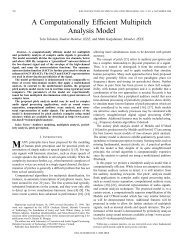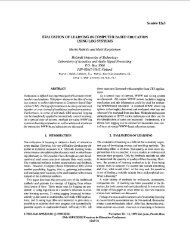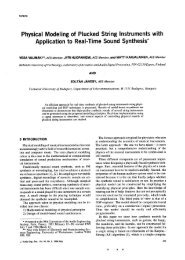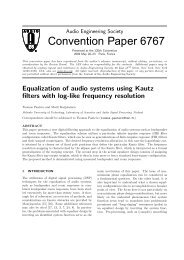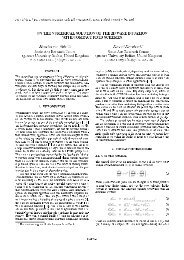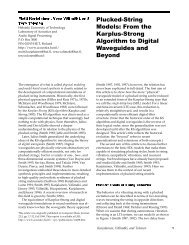Splitting the Unit Delay - IEEE Signal Processing ... - IEEE Xplore
Splitting the Unit Delay - IEEE Signal Processing ... - IEEE Xplore
Splitting the Unit Delay - IEEE Signal Processing ... - IEEE Xplore
Create successful ePaper yourself
Turn your PDF publications into a flip-book with our unique Google optimized e-Paper software.
implying thatOetken also observed that <strong>the</strong> amplitude ripple is not <strong>the</strong>same for all <strong>the</strong> polyphase branches (in our case: for allNh(n)LJnRk = e-jakNI2, k = 1,2 ,..., Kfractions of <strong>the</strong> delay). Instead, it depends on <strong>the</strong> fractionaln=O (47) part d in <strong>the</strong> following manner [go]:where NI2 is <strong>the</strong> delay of <strong>the</strong> filter. Assuming that <strong>the</strong> zerosremain <strong>the</strong> same for noninteger values of D as well, <strong>the</strong> filtercoefficients can be solved from Eq. 47 for a chosen total delayD, which is close to Nl2. This can be expressed in matrix formaswhereisaKx(N+ 1)matrixand(494where 61,2 is <strong>the</strong> maximum amplitude ripple of <strong>the</strong> linearphaseprototype filter with <strong>the</strong> delay D = N/2 (= Int(D) + 112)and Sd is <strong>the</strong> ripple of a filter approximating <strong>the</strong> (noninteger)delay D with <strong>the</strong> fractional part, d. Note that <strong>the</strong> amplituderipple is largest in <strong>the</strong> linear-phase case (D = NI2 or d = 0.5)and reduces to zero when <strong>the</strong> fraction approaches an integervalue (d = 0 or d = l), which corresponds to <strong>the</strong> case that <strong>the</strong>impulse response reduces to a unit pulse. The almost-equirippleapproximation computed using <strong>the</strong> Oetken method isillustrated in Fig. A6. The 4-tap FIR filter does not have manyripples, but <strong>the</strong> 10-tap filter responses are seen to be veryclose to equiripple.Relation to Interpolation/Decimation FIR Filters-jDQl ,-jDQ, ,-jDOk T As already discussed above, <strong>the</strong> polyphase structure of decieD=[e ...l(49b) mationlinterpolation filters can be utilized for fractional delayimplementation with fixed steps ([5, 9, 23, 24, 741). ForEquation 48 is a set of K complex equations with L = 2Kexample, in order to break <strong>the</strong> unit delay into Q steps, one canwhich can be expressed as asetdesign a Qth-band lowpass filter with <strong>the</strong> normalized pass-Of equations by equating <strong>the</strong> and parts band width of Q and form <strong>the</strong> Q-branch polyphaseof both sides asby picking up every Qth sample to one branch. It can beshown that each band approximates a fractional delay of <strong>the</strong>(50a) valuewithandPa =[;IPn = [ 3where <strong>the</strong> matrices and vectors contain appropriate cosineand sine elements such that Ea = Cn -j&, and e D= c D-jsD.Note that <strong>the</strong> design scheme can be interpreted as a complexversion of <strong>the</strong> frequency sampling technique [84] where <strong>the</strong>frequency samples are unequally spaced.Hence, one first has to design <strong>the</strong> linear-phase prototypefilter, to find its zero frequencies Qk and <strong>the</strong>n to invert <strong>the</strong>cosine-sine matrix of Eq. 50b. Since <strong>the</strong> zeroes of <strong>the</strong> phaseerror function need not be known with high precision, simplenoniterative search on <strong>the</strong> employed frequency grid is sufficientin general. After that, <strong>the</strong> coefficients of a new filterapproximating any given delay are readily obtained via asingle matrix multiplication. Note that matrix Eq. 50b isindependent of <strong>the</strong> delay D and only needs to be inverted onceoff-line so that <strong>the</strong> approach is suitable for real-time coefficientupdate.D=e-k, k=0,1,2 ,..., Q-IQThe accuracy of approximation depends naturally on <strong>the</strong>length of <strong>the</strong> prototype Qth-band lowpass filter. In order toachieve comparable frequency response for each branch, <strong>the</strong>length of <strong>the</strong> prototype filter should be a multiple of Q. Thelowpass filter should be linear-phase, but it can be designedwith any method. However, <strong>the</strong> optimality of <strong>the</strong> prototypefilter is not shared with <strong>the</strong> branch filters; e.g., equiripplemagnitude characteristic will be lost.The multirate approach is straightforward and well suitedfor table look-up applications. If one is satisfied for example,with Q = 50-step division of <strong>the</strong> unit delay, one simplydesigns a length-501 filter and uses <strong>the</strong> desired length4 filterof <strong>the</strong> set.However, small delay steps and strict specifications for <strong>the</strong>approximation error may result in an FIR filter with hundredsof taps, which makes it impossible to use <strong>the</strong> Parks-McClellanalgorithm for <strong>the</strong> prototype design. In that case, windowingmethods may be used for which <strong>the</strong>re is practically no limitfor <strong>the</strong> filter order. However, as <strong>the</strong>re are several o<strong>the</strong>r simplemethods that provide smaller error, <strong>the</strong> multirate approachnow appears somewhat outdated for this application.For reference, we chose Q = 10 to design prototype filtersof lengths 40 and 100 to provide a set of length-4 andJANUARY 1996 <strong>IEEE</strong> SIGNAL PROCESSING MAGAZINE 43






